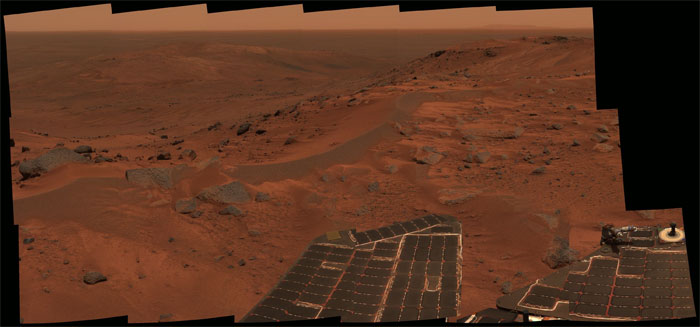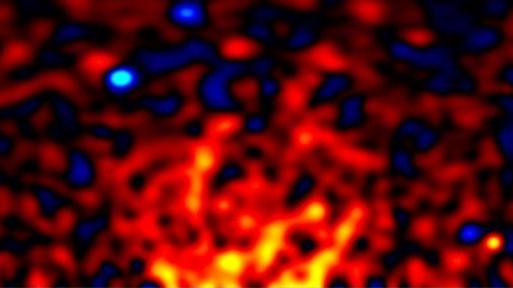Rocky Mountain High: Spirit Rover Surveys its Surroundings

This story was updated at 4:24 p.m.EDT.
NASA's Marsrover Spirit is experiencing the robotic high life--literally--now that it hasreached to top of Husband Hill after a slow, year-long climb.
Perchedsome 270 feet--about the height of the Statue of Liberty--above the plains of itsGusev Crater landing site, Spirit has returned imagesof stunning new vistas that include a potential winter refuge as the Martianseasons progress, mission scientists said Thursday during a press conference atNASA's Washington, D.C. headquarters.
"That's noMt. Everest, but it's a heck of a climb for our little rover," Steve Squyres, principal investigator of the rover's sciencemission at Cornell University in Ithaca, New York, told reporters. "When wefirst touched down at Gusev Crater on Jan. 4, 2004,the Columbia Hills looked impossibly far away."
Spiritspent 591 Martian days roving across the 1.5 miles (three kilometers) betweenits landing point and the summit of Husband Hill, one of a network of rises inthe Columbia Hills chain. One Martian day, or sol, is about 24 hours and 40minutes.
The rover reachedthe base of the Columbia Hills, a chain named after the lost STS-107astronauts--in June 2004. The layered rocks, which Spirit later found werechanged by water in the planets ancient past, and tricky terrain were a welcomechange for researchers, who until then found almost nothing but the same,basalt rocks--the most basic type of rock--day after day of exploring Gusev Crater.
"The rocksin the Columbia Hills are nothing like the basalt on the plains," said Ray Arvidson, deputy principal scientist for the rover sciencemission at Washington University in St. Louis, Missouri, during the pressconference. "Water was involved in practically every one that we've seen sofar."
Breaking space news, the latest updates on rocket launches, skywatching events and more!
Squyressaid Spirit engineers and researchers will spend the next week to 10 daysdiscussing when to leave the summit, though the rover will likely not stayatop Husband Hill for many months.
Researchershave already picked out a long-distance target dubbed Home Platein basin to the south of Spirit's current location. A north-facing slope on theside of another hill, known as McCool Hill, may offer a prime spot to weatherthe Martian winter since the rover's solar arrays would be angled toward theSun to collect the most sunlight.
"Thedeciding factor will be how good the geology is," Squyressaid of the time it will take to descend Husband Hill. "I think going downhillhas the potential to go a bit faster, it's easier to go downhill with thesevehicles than going up."
Opportunity's Rind
WhileSpirit took the high road at Gusev, its robotic twinOpportunity has made steady progress across the rocky etched terrain of Meridiani Planum on the otherside of Mars.
Despite astill unexplained software glitch, in which Opportunity reset itself on Aug.21, the rover has given researchers their first glimpse into an odd coating - knownas a 'rind' - that covers some rocks at Meridiani.
"We've beenvery curious to figure out what they are," Squyressaid.
Opportunityused its robotic arm-mounted microscopic imager and rock-grinding abrasion toolto compare a bare rock dubbed "Strawberry" with a coated area called "LemonRind." While essentially identical in most respects, Lemon Rind contains higherlevels of sodium and chlorine than Strawberry.
"Onepossibility is that it's the last layer to form," Squyressaid of Lemon Rind's coating, adding that the rind may also have formed muchlater, after both rocks were deposited at Meridiani."It speaks to yet another water episode."
Engineershave slowly been recertifying Opportunity since the software reset even as itcontinues its science operations, researchers said.
"I thinkthe reset itself was more of an annoyance," said Jacob Matijevic,who heads the rover engineering team at NASA's Jet Propulsion Laboratory (JPL)."I'd sure like to know what exactly took place."
Spirit andOpportunity are currently funded through December 2006, with scientific targetsset in six-month sections, NASA's Mars Exploration Program chief Doug McCuistion said.
While therovers show some signs of age - the rock grinding bits of Spirit's rockabrasion tool are so worn, they're only useful for brushing targets clean--theyare still generating ample supplies of power, rover handlers said.
"As long asthese vehicles remain healthy and continue on their science return we'llcontinue," McCuistion said. "An asset on the[Martian] surface like this is invaluable...and we certainly don't want to cutthem off.

Tariq is the award-winning Editor-in-Chief of Space.com and joined the team in 2001. He covers human spaceflight, as well as skywatching and entertainment. He became Space.com's Editor-in-Chief in 2019. Before joining Space.com, Tariq was a staff reporter for The Los Angeles Times covering education and city beats in La Habra, Fullerton and Huntington Beach. He's a recipient of the 2022 Harry Kolcum Award for excellence in space reporting and the 2025 Space Pioneer Award from the National Space Society. He is an Eagle Scout and Space Camp alum with journalism degrees from the USC and NYU. You can find Tariq at Space.com and as the co-host to the This Week In Space podcast on the TWiT network. To see his latest project, you can follow Tariq on Twitter @tariqjmalik.
